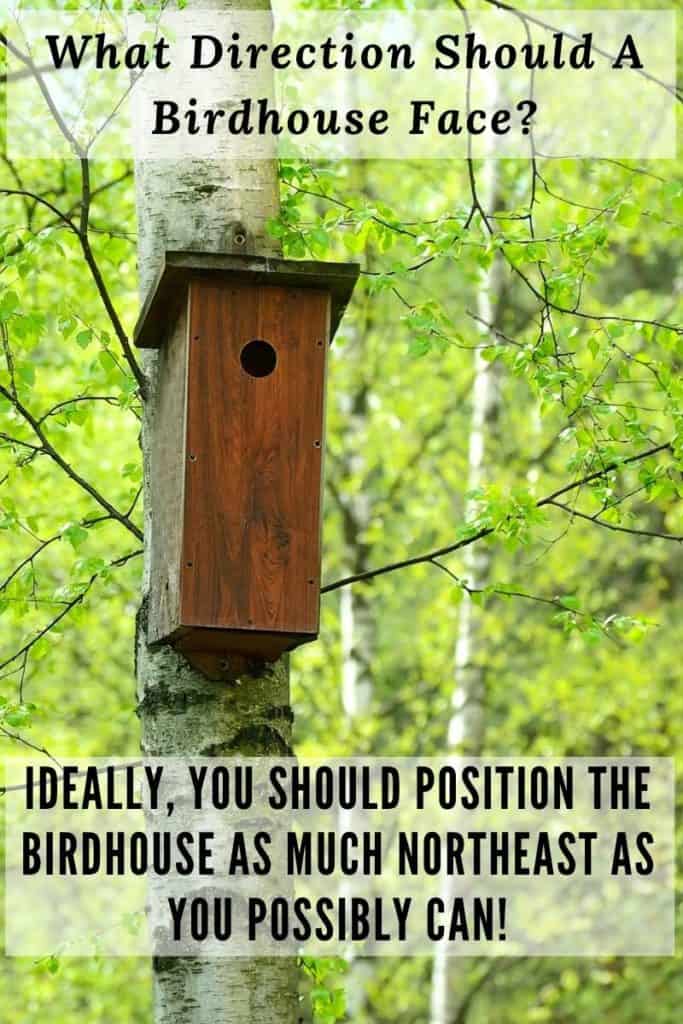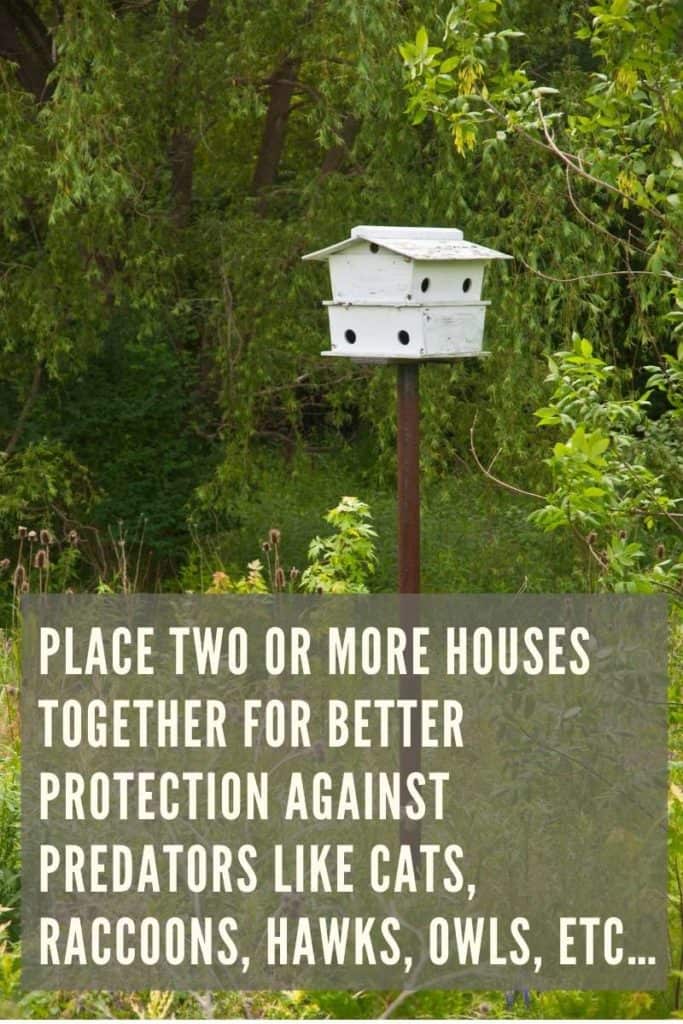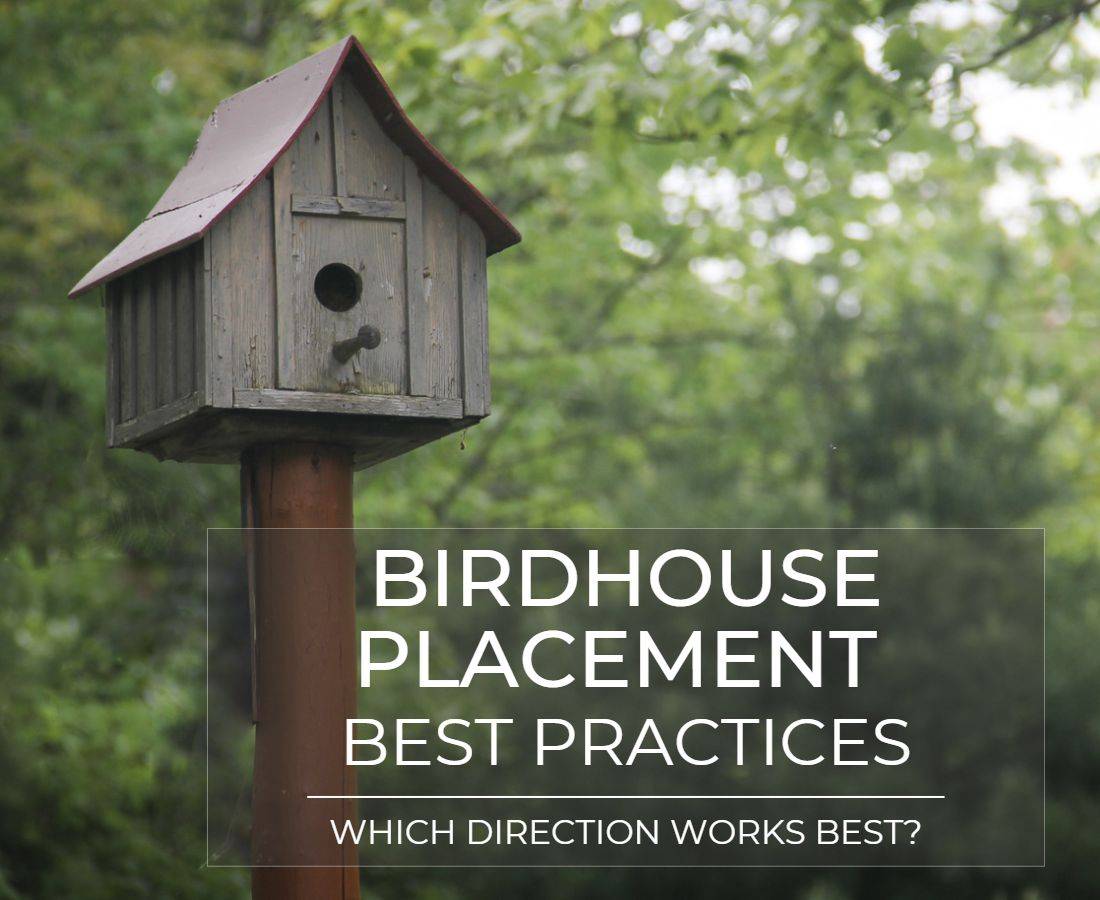Did you know that the direction your birdhouse faces plays a crucial role in attracting feathered friends? Yes, it’s true, the ideal direction is generally east. But why is that? What makes an east-facing birdhouse so special?
Table of Contents
This seemingly trivial detail can have significant consequences for your avian guests. Stick around as we delve into the fascinating world of bird behavior, habitats, and the factors that influence the perfect placement of your birdhouse.

Birdhouse Placement and Orientation: Best Practices
The placement and orientation of a birdhouse can significantly impact its appeal to birds and their safety. Check the 11 factors below to get an ideal setup for your birdhouse.
1) Why the Birdhouse and Entrance Hole Should Face Away from Prevailing Winds
Facing the birdhouse and its entrance hole away from prevailing winds provides a more comfortable environment for birds. It shields the nest from cold drafts and prevents rain from entering, which can be crucial for the survival of the young birds.
2) The Benefits of East-Facing Birdhouses in the United States
In the United States, birdhouses facing east are generally preferable. This orientation exposes the birds to the warm morning sun and shields them from the harsh afternoon heat, providing optimal temperature conditions for nesting birds.
3) The Relevance of Bird Feeders Advice to Birdhouse Placement
Birdhouse placement shares similarities with bird feeder placement advice. They should be placed at a safe distance from potential predators yet close enough to trees or shrubs for birds to take refuge if needed.
4) The Role of Trees, Shrubs, and Open Areas in Providing Perching, Hunting, and Landing Spots for Birds
Trees, shrubs, and open areas near birdhouses provide crucial perching, hunting, and landing spots. These environments offer birds a natural habitat and make the birdhouse more attractive to potential nesters.
5) Sun Exposure
It’s beneficial for a birdhouse to face the direction that provides the most appropriate amount of sunlight. In many regions, this would be eastward, to catch the warm morning sun and avoid the intense heat of the afternoon.
6) Predator Access
Ensure the birdhouse faces a direction that makes it difficult for predators to access. Positioning it too close to a tree or structure can provide an easy pathway for creatures like cats and squirrels.
7) Bird Species
Different bird species have different preferences. Understanding the specific needs of the species you’re trying to attract can greatly influence the birdhouse’s direction.
8) Surrounding Environment
Consider the surrounding environment. The birdhouse should be placed in a quiet, peaceful area with a clear flight path to the entrance.
9) Accessibility
The birdhouse should be easily accessible for cleaning and monitoring, but not too accessible that it’s disturbing for the birds. This often influences the direction and location of the birdhouse.
10) Birdhouse Design
Different bird species prefer different types of birdhouses. The design, including the entrance hole size and placement, can influence the direction the birdhouse should face.
11) Weather and Climate Conditions
The local climate and weather conditions can also influence the direction a birdhouse should face. In hotter climates, it may be beneficial to face the birdhouse in a direction that provides shade during the hottest part of the day.
12) Away from Feeders and Baths
Considering birdhouse orientation also includes its proximity to bird feeders or baths. These bustling spots can stress birdhouse occupants, especially those guarding fledglings.
Ensure your birdhouse is distanced from these areas to provide a peaceful, secure environment for your avian guests.
Interestingly, a study was performed by the Cornell Lab of Ornithology regarding which direction is best for a birdhouse. Citizens across the U.S. participated and sent in the information they collected on what they had observed, and it showed that in more northern states, Eastern bluebirds preferred a birdhouse facing the east.
Why? Well, scientists at Cornell believe it is because the sun rises in the east. With the birdhouse facing the sun as it rises, this helps introduce warmth early on in the day, which proved beneficial on those somewhat chilly nights that can occur in those more northern states. This brings us to the next point as to why birdhouses facing east are helpful; the sunrise provides warmth after losing all that heat overnight that was attained during the day.
Understanding Bird Habitats and Nesting Preferences
Every bird species has unique habitat preferences which greatly influence their nesting habits. Factors like geographical location, availability of food and water, and the presence of certain types of trees or plants can all play a role.
The Role of Birdhouses in Compensating for Habitat Loss
Birdhouses play a critical role in compensating for the loss of natural nesting spaces due to deforestation and urbanization. Providing birdhouses can help ensure the survival and propagation of bird species affected by habitat loss.
Species-Specific Birdhouse Preferences
Birdhouses aren’t one-size-fits-all. For instance, the size of the entrance hole, the depth of the house, and its overall dimensions can significantly influence which species will nest in it. Crafting species-specific birdhouses is a great way to attract specific birds to your garden.
Introduction to Cavity-Nesting Birds and Their Nesting Habits
Cavity-nesting birds, like bluebirds and chickadees, typically nest in holes or cavities in trees. Birdhouses that mimic these natural habitats can attract these birds.
The top 10 key factors for placing a birdhouse
Understanding how to properly place a birdhouse is paramount for attracting birds and ensuring their comfort and safety.
The table below summarizes the top 10 key factors to consider when choosing a location for your birdhouse. From direction and height to proximity to feeders and other birdhouses, each element plays a critical role in creating an ideal environment for nesting birds.
| Factor | Description |
|---|---|
| Direction | The birdhouse and entrance hole should face away from prevailing winds. Common practice is to face the birdhouse east. |
| Location | Consider placement criteria beyond wind direction such as distance from bird feeders and bird baths and proximity to existing birdhouses. |
| Height | Birdhouses should be placed at least five feet above ground with specific height preferences for certain bird species. |
| Entrance Hole | The size and direction of the entrance hole are crucial to keep the birds safe from predators and weather conditions. |
| Attractiveness | The birdhouse should be attractive to the birds, considering aspects like color and design. |
| Predator Protection | The birdhouse should have measures to deter predators, such as a sturdy mount or no perches. |
| Material and Design | Birdhouses should be made of sturdy, non-toxic materials and designed to suit the nesting habits of the species you aim to attract. |
| Ventilation and Drainage | Good birdhouses should have appropriate ventilation to prevent overheating, and drainage holes to keep the interior dry. |
| Easy Access for Cleaning and Maintenance | Birdhouses should be designed for easy cleaning and maintenance. Regular cleaning helps to keep the birds healthy and encourages them to return year after year. |
| Peace and Quiet | Ensure peace, quiet, and privacy for nesting birds. Too much human disturbance can deter birds from nesting in the birdhouse. |
When to Set Up Birdhouses
Timing is Key: Fall and Winter Placement
Despite common intuition suggesting that spring, with its flurry of nest-building, is the ideal time to place birdhouses, it is actually more beneficial to set them up in the fall or winter. This earlier setup gives birds ample opportunity to locate these potential nesting sites ahead of their breeding season. It also allows them to get accustomed to the presence of these structures, increasing the likelihood of habitation when spring arrives.
Housekeeping for Birdhouses: Cleaning Out Old Nests
To prepare for the influx of feathered tenants, ensure that any existing birdhouses are thoroughly cleaned out, removing old nesting materials. This routine housekeeping ensures that your birdhouses are inviting and ready for the springtime residents.
Early Spring Preparations: Providing Nesting Materials
As early spring approaches, you can aid your local avian community by providing nesting materials. Items such as dryer lint, strands of thread, or even pet hair can be left out near bird baths and feeders.
However, it’s important to keep these materials at a distance from the birdhouses. Too close, and you might inadvertently advertise the location to predator birds, risking the safety of your intended occupants.
Your goal is to create a safe, welcoming environment that supports the vibrant life cycle of our feathered friends.
Bird Species and Their Preferred Birdhouse Orientation
Different bird species have specific preferences when it comes to birdhouse orientation. These preferences often relate to their natural habitats and behaviors.
Eastern Bluebirds
Eastern Bluebirds favor birdhouses that face east, possibly as a means to catch the morning sun and avoid harsh afternoon heat. Their natural predilection for open habitats makes them less picky about the presence of nearby vegetation.
Chickadees and Titmice
Chickadees and Titmice are not particularly fussy about direction, but they do prefer an entrance hole that is concealed by some foliage, offering them a sense of security and a stealthy approach to their nesting site.
Purple Martins
Purple Martins are colonial birds, preferring to nest in groups. Birdhouses for Purple Martins should ideally be placed in the open and can face any direction. The key factor for them is the birdhouse’s location – they prefer areas near water bodies.
Woodpeckers
Woodpeckers, being natural cavity nesters, favor birdhouses that face south or southeast. This orientation helps them stay warm during their early breeding season, which often starts in the chill of late winter.
Wrens
Wrens, on the other hand, are more flexible with their birdhouse orientation. They’re primarily concerned with the safety and security of their nest, and will appreciate a birdhouse that’s well-hidden and shielded from predators.
Understanding the preferences of the bird species you wish to attract can significantly enhance your success in providing them a suitable and welcoming habitat.
Swallows
Swallows prefer birdhouses that face eastward, which allows them to take advantage of the morning sun. They also prefer birdhouses to be situated near open fields or bodies of water where they can easily hunt for insects.
Sparrows
Sparrows are not particular about the orientation of their birdhouses, but they do prefer that birdhouses be located near busy areas. Their adaptability to human environments makes them less particular about the birdhouse’s specific location.
Nuthatches
Nuthatches prefer birdhouses that face towards the southeast, allowing them to get the morning sunlight while being protected from the harshest elements of weather. They also prefer birdhouses that are located near trees.
Owls
Owls, specifically Screech Owls and Barn Owls, prefer their birdhouses to face towards the east, providing a clear line of sight of potential predators and allowing them to take advantage of the early morning light.
Robins
Robins prefer their birdhouses to face either north or east. They also prefer birdhouses that are located in quiet areas with low human activity.
Pigeons
Pigeons are not particular about birdhouse orientation, but prefer them to be in high places that mimic their natural cliff-dwelling habitats.
Ducks
Ducks, specifically Wood Ducks, prefer their birdhouses to face towards the water, making it easier for them to find and navigate back to their nests.
Flycatchers
Flycatchers, like the Eastern Phoebe, are flexible about their birdhouse orientation. They prefer their birdhouses to be located near water and insect-rich areas.
Finches
Finches aren’t particularly choosy about birdhouse orientation, but do prefer that their birdhouses are located in quieter, less busy areas.
Doves
Doves prefer their birdhouses to face towards the east or south, capturing the morning sun and afternoon warmth. They also prefer birdhouses that are located in quiet areas, away from heavy human activity.
Comprehensive Guidelines for Ideal Birdhouse Placement
To assist our feathered friends in finding a safe, cozy home, consider these comprehensive guidelines for perfect birdhouse placement.
| Guideline | Reason | Additional Notes |
|---|---|---|
| The birdhouse should face south | Maximizes the sun’s warmth | – |
| Position the birdhouse at least 10 feet off the ground | Enhances protection | Use a tree or a specially made post |
| Avoid placing the birdhouse near power lines | Prevents potential electrical hazards | – |
| Do not place a birdhouse on the roof | Birds are sensitive to extreme temperatures | Heat or cold could harm the birds |
| Cluster birdhouses together | Provides better protection against predators | Ensure there is sufficient space between the houses |
| Stock the birdhouse with food | Attracts birds and promotes repeat visits | Replenish food regularly |
| Locate birdhouses near water if possible | Birds prefer to build nests close to water | – |
| Place the birdhouse to face east or west | Provides a place for birds to rest | Both day and night birds will be attracted |
| Hang the birdhouse on a tree if there are many in the area | Provides a natural and safe environment for birds | – |
| Ensure plenty of space around the entrance hole | Offers safety from predators | Helps birds feel secure |
| Consider wind patterns when choosing birdhouse placement | Birds want stable homes | Avoid areas with strong wind gusts |
| Clean the birdhouse after installation | Attracts more birds | Keep the birdhouse fresh and inviting |
| Avoid placing birdhouses in overly noisy areas | Noise can stress birds and deter nesting | – |
| Tilt the birdhouse slightly downwards | Prevents rain from entering the birdhouse | – |
| Use natural, untreated wood for birdhouses | Birds prefer natural materials | Avoids potential toxicity from treated wood |
| Choose a birdhouse with an overhanging roof | Protects the entrance from rain and predators | – |
| Consider the birdhouse’s color | Lighter colors reflect heat and are less attractive to predators | – |
| Ensure proper ventilation and drainage in the birdhouse | Promotes a healthy environment for the birds | – |
| Install a predator guard or baffle | Provides additional protection | Particularly important in areas with many predators |
| Leave some distance between birdhouses | Prevents territorial disputes | Different species have different requirements for space |

Conclusion
Enhance your birdwatching experience by adding birdhouses to your yard, and remembering to prioritize function over decoration.
Favor natural, unpainted wood to avoid overheating risks associated with plastic or metal.
Keep in mind, simplicity wins: a northeast or east-facing birdhouse invites more birds, providing a serene haven for nurturing their young.
In case you wanna build a swallow birdhouse yourself, read our article.
FAQs
Where is the best place to put a birdhouse?
The best place to put a birdhouse is in a quiet and sheltered location, away from direct sunlight and prevailing winds. It should be mounted securely on a pole or a tree, at least 5 feet above the ground to deter predators. Providing a peaceful and safe environment encourages birds to nest.
Where is the best place to put a bluebird house?
For bluebirds, the best place to put a bluebird house is in an open area with sparse vegetation, preferably facing east. Mount it on a pole or a fence post, around 4-6 feet above the ground, with clear flight paths leading to the entrance hole. This helps mimic their natural habitat and increases their chances of nesting.
What are the standards for a birdhouse?
Standards for a birdhouse include having an appropriate entrance hole size to deter unwanted species, proper ventilation to prevent overheating, drainage holes to avoid water accumulation and easy access for periodic cleaning. Using non-toxic, durable materials ensures longevity, and providing sufficient space for nesting and roosting promotes bird well-being.


It’s great that you mentioned how simple is best when it comes to birdhouses. I really like birds and I think it would be nice to have some of them visiting our backyard. So for that, I am thinking of getting some rustic wood birdhouses.
Excellent article! Thank you for the specifics for the different species.
I’m glad you found the article helpful! It’s always rewarding to know the specific needs of different bird species, isn’t it? If you have any more questions or need further tips on birdhouse placement, feel free to ask. Happy birdwatching!